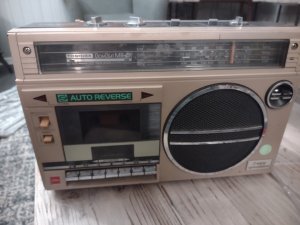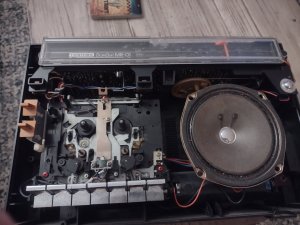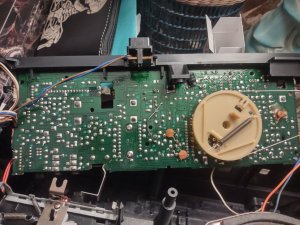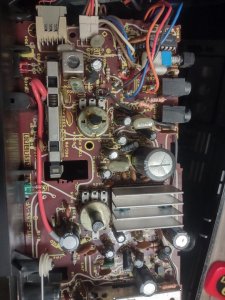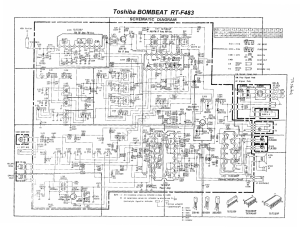Hi all, I picked up this Toshiba RT-F483 because I have a thing for mono boomboxes as well as mono boomboxes where the cassette is right side up. I want to preface all this by saying I am a complete novice to this hobby. I know how to solder and I own a multimeter but that's about it. I have replaced belts and cleaned tape heads ect but I would have no idea where to start to try and diagnose the problem with this box.
Anyway, The issue is it has power but no sound output whatsoever. The radio seems to work (you can see the tuning light change when you find a good station) and you can hear the cassette motor run when you press play even though the belts are toast but there is no sound from either the speaker or from the headphone output.
As a side note, I'm in the USA and as far as I can tell this might be a European model as the power input is actually 220v. It looks like the person who had it before me was trying to power it off of 110v and I wonder if that could have damaged the circuitry. So I'm powering it off of batteries for now. I cant find a service manual or a schematic (not that I would know how to read it) in fact there isn't much info on this box at all that I can find. Just this one page...
https://www.radiomuseum.org/r/toshiba_radio_cassette_recorder_rt_f483.html
I've looked at the circuit board and can't see a single cracked solder joint, I don't see any obvious leaking capacitors or anything but then again I don't really know what I'm looking for. I have a feeling repairing this thing may be above my pay grade, but I thought I'd at least give it a try...
Just wondering if there are any obvious things I can try before throwing in the towel on this bad boy...
Thanks
Anyway, The issue is it has power but no sound output whatsoever. The radio seems to work (you can see the tuning light change when you find a good station) and you can hear the cassette motor run when you press play even though the belts are toast but there is no sound from either the speaker or from the headphone output.
As a side note, I'm in the USA and as far as I can tell this might be a European model as the power input is actually 220v. It looks like the person who had it before me was trying to power it off of 110v and I wonder if that could have damaged the circuitry. So I'm powering it off of batteries for now. I cant find a service manual or a schematic (not that I would know how to read it) in fact there isn't much info on this box at all that I can find. Just this one page...
https://www.radiomuseum.org/r/toshiba_radio_cassette_recorder_rt_f483.html
I've looked at the circuit board and can't see a single cracked solder joint, I don't see any obvious leaking capacitors or anything but then again I don't really know what I'm looking for. I have a feeling repairing this thing may be above my pay grade, but I thought I'd at least give it a try...
Just wondering if there are any obvious things I can try before throwing in the towel on this bad boy...
Thanks
Attachments
-
112.6 KB Views: 17
-
134.8 KB Views: 18
-
184.4 KB Views: 18
-
178.4 KB Views: 17
-
176.6 KB Views: 17
-
167.5 KB Views: 26


